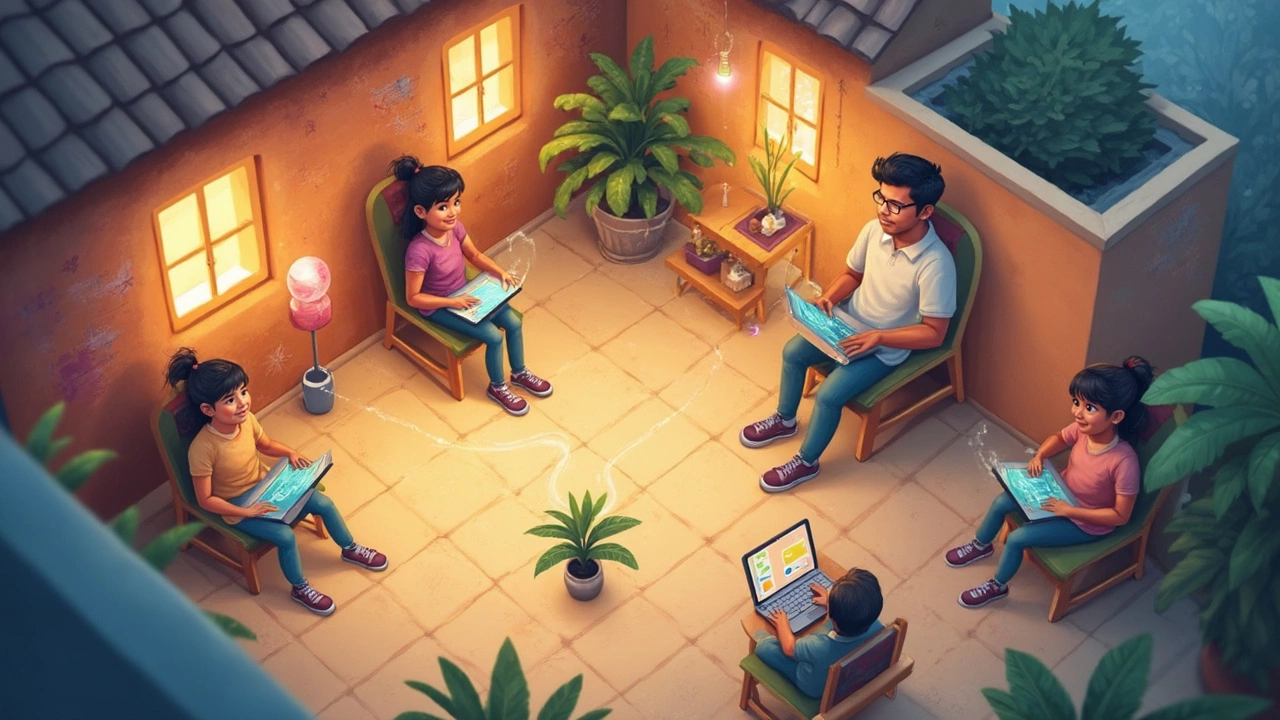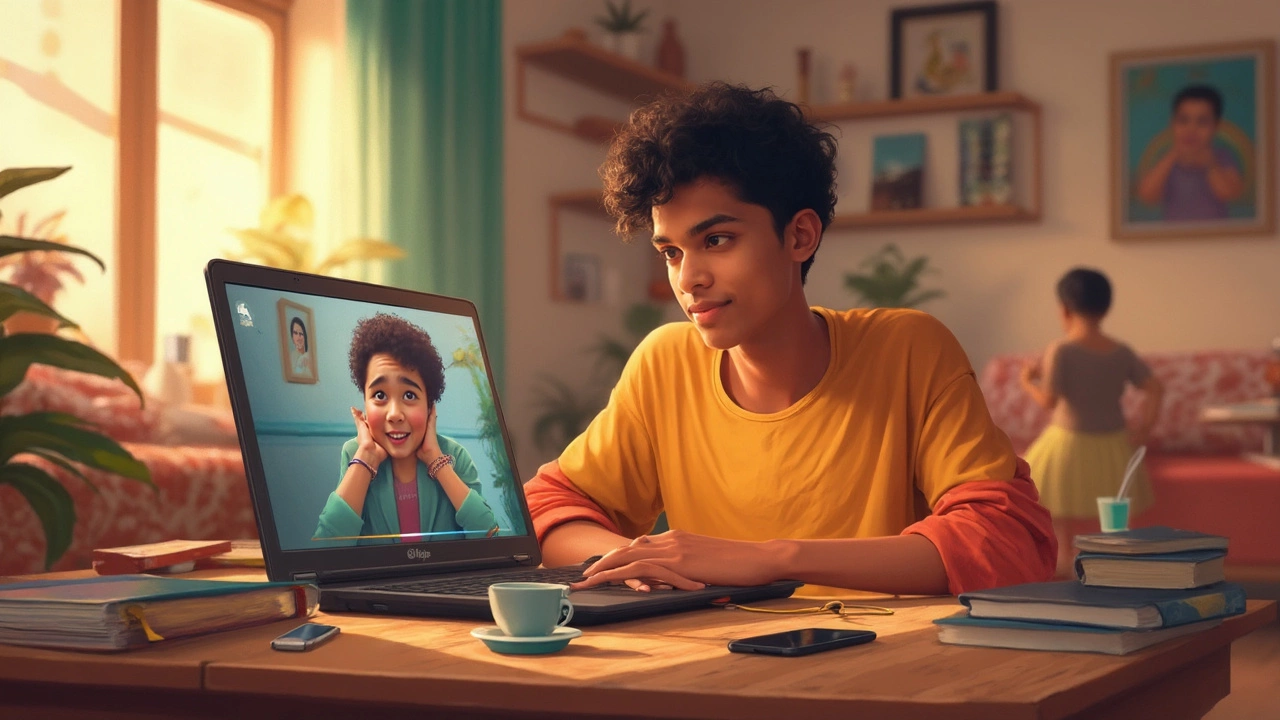Most people think ‘distance’ in education is just about how far you live from a school. But it’s a whole lot more than that. Distance education is really about learning when you and your teacher aren’t in the same place, and sometimes, not even at the same time. You might be at your kitchen table in pajamas, while your teacher is halfway across the country drinking coffee.
Distance took on a whole new meaning when kids started doing classes on Zoom or when workers pick up new skills from their living rooms. In old-school distance learning, lessons showed up in your mailbox. Now? It’s right on your phone, your laptop, or whatever screen you use. You don’t just save on travel—you control your study space, your hours, even when you participate.
- Breaking Down 'Distance' in Distance Education
- How Do People Learn from Afar?
- Tools That Make Distance Feel Shorter
- Who Thrives—and Who Struggles—in Distance Education
- Getting the Most Out of Remote Learning
Breaking Down 'Distance' in Distance Education
When we talk about distance in distance education, we’re not just measuring miles. This kind of learning came to life way before the internet. The first real taste of remote learning started in the 1800s with correspondence courses—people mailed assignments back and forth to schools. These days, the idea is the same: students and teachers aren’t under the same roof, but now, it’s usually digital instead of postal.
This ‘distance’ doesn’t just mean you’re physically apart. It can also mean you study at different times. That’s called asynchronous learning. Maybe you watch recorded lectures at midnight while your instructor uploads new materials in the morning. Or it can be synchronous, like live video calls, where everyone jumps online together.
Distance education removes a ton of barriers—no need for campus housing, no long commutes, no worrying about moving to another city. The National Center for Education Statistics (NCES) reported that during 2021, about 60% of college students in the U.S. were taking at least one online class. That’s a huge shift from just a few years ago.
"Distance education gives equal learning opportunities to people no matter where they live or what their schedule looks like." — EDUCAUSE Review
Here’s what distance really means for education today:
- Students choose where and sometimes when they want to learn.
- Classes can include people from all over the world, with loads of backgrounds and time zones.
- Learning is supported by tech—everything from basic email to advanced interactive apps.
- Feedback and communication often happen over chat, email, or video, not face to face.
So, the essence of 'distance' isn’t just about geography—it's about freedom, flexibility, and the tech tools that keep everyone connected even when they’re apart.
How Do People Learn from Afar?
The days of waiting for a big box of textbooks in the mail are mostly over. Now, most people use the internet to connect with teachers, classmates, and course materials, no matter how far apart they are. It all comes down to a mix of technology and creativity.
With distance education, you don't have to sit in a classroom to get the same lessons as everyone else. Here’s how people make it work:
- Live Classes: Tools like Zoom, Google Meet, and Microsoft Teams let everyone join video calls at the same time. Teachers can share slides or write on a virtual whiteboard while students ask questions in real time.
- Recorded Lessons: Instead of tuning in live, some classes are recorded. You can watch them on your own schedule—say after work or whenever it fits. Super helpful if you’re juggling a job or family.
- Discussion Forums: Many platforms use chat boards or app-based forums. Students ask questions, post answers, or just cheer each other on. It makes up for not hanging out together between classes.
- Assignments and Quizzes: These are posted online. You send in your work or take timed tests—no printing, scanning, or snail-mailing.
- Group Projects: Apps like Google Docs or Slack let people work together, even if they’re on different continents.
Here’s a quick look at who’s learning remotely these days and how:
| Type of Learner | Common Tools Used | Why It Works |
|---|---|---|
| College Students | Moodle, Canvas, Blackboard | Fits around part-time jobs and busy schedules |
| Working Adults | Online webinars, mobile apps | Can study after work hours or during breaks |
| K-12 Kids | Google Classroom, Zoom | Attend school from home during disruptions |
| Remote Learners Worldwide | WhatsApp, Open course websites | Brings study options to remote or rural places |
Recent data showed that in 2024, more than 60% of U.S. college students took at least one course fully online. That number’s only going up, especially as more jobs and universities accept remote credentials. When people say “learning from afar,” they mean using whatever tech it takes to bring a classroom to your screen.

Tools That Make Distance Feel Shorter
The right tools turn distance education into something that feels way more connected than it sounds. Some folks think you need fancy gear, but that’s not the case. Most people get by with the basics—solid Wi-Fi, a computer or even just a phone, and the right apps.
The real magic happens through virtual meeting platforms. Programs like Zoom, Microsoft Teams, and Google Meet let you see and talk to classmates and teachers, all in real time. These platforms exploded in popularity. For instance, Zoom grew from 10 million daily users in December 2019 to over 200 million by April 2020—that’s not just a spike, that’s a whole new way of learning.
Learning Management Systems (LMS) like Canvas, Moodle, and Google Classroom help keep things organized. They’re like digital backpacks, making it easy to turn in assignments, get grades, and message your teacher. No more lost papers or guessing if you missed a deadline.
There are also collaboration tools, like Google Docs and Padlet, that let students work together, even if they’re continents apart. These tools make group projects actually doable without anyone meeting in person.
- distance education platforms offer mobile apps, so you can join class from almost anywhere—on the bus, at a café, or your couch.
- Scheduling and reminder apps, like Google Calendar, keep you from forgetting class times or deadlines.
- Forums like Piazza or even simple group chats make it easy to get help from classmates—or vent about tough assignments.
Just in case you want some numbers to chew on, check this out:
| Tool/Platform | Reported Users (2024) | Main Function |
|---|---|---|
| Zoom | 300+ million daily meeting participants | Video conferencing |
| Google Classroom | 150 million | Classroom management |
| Canvas LMS | 30 million | Assignments/grading |
| Google Docs | 2+ billion | Document collaboration |
All these digital tools pull everyone closer together. Honestly, they make distance education feel a whole lot less distant.
Who Thrives—and Who Struggles—in Distance Education
Not everyone gets the same results from distance education. Some folks absolutely love it. They get a boost from the freedom to plan their own schedule, choose when to do their work, and avoid packed classrooms. Usually, people who are really good at managing their own time or are already pretty independent do well with distance learning. If you’re the kind of person who sets reminders, makes checklists, or just can’t stand noisy distractions, remote study can be your thing.
On the flip side, some students hit real roadblocks. Teens and kids who need regular face-to-face support sometimes find it hard to stay motivated staring at a screen. According to data from the National Center for Education Statistics, online dropout rates are higher for students who struggle with self-discipline or don’t have reliable access to the internet. Students who don’t have a quiet place at home or have to share devices with others also tend to struggle.
Teachers notice the difference, too. Some thrive when using digital tools or love recording video lessons they can reuse. Others dislike not seeing students’ faces and miss the little social cues that tell them if someone’s confused or needs help.
If you’re thinking about trying distance learning, here’s what tends to help people thrive:
- Keeping a solid daily routine—even if you don’t have a set class time.
- Setting up a study spot that’s as distraction-free as possible.
- Asking for help early instead of waiting and falling behind.
- Using apps or timers to break big assignments into chunks.
But if you know you do better with in-person chats and you like classrooms buzzing with action, distance education might not be your top choice—and that’s totally fine, too. It helps to know your style before making the switch.

Getting the Most Out of Remote Learning
Remote learning can feel like a bit of a maze at first, but once you spot what works, you can save a lot of time and stress. The biggest thing? Routine. Set up a study schedule and actually stick to it. Treat online classes like you would if you were physically heading to a real classroom. Get out of bed, brush your teeth, grab a snack, and get to your workspace—no, your pillow doesn’t count as a desk.
Stay organized. Most people lose points (and motivation) just by missing deadlines or forgetting assignments. Keep a list—paper, app, whiteboard, whatever—and cross stuff off as you go. Some students swear by calendar apps with reminders, and hey, it works for adults too.
Don’t ignore your teacher or classmates just because you’re not sitting in the same room. Ask questions if you’re stuck. Every major platform (Zoom, Google Meet, Microsoft Teams) has chat features, and plenty of schools use forums or messaging groups where you can connect. If you’re shy, just type in the chat box—someone else probably has the same question.
Distractions will wreck your focus if you let them. Put your phone face down, close game tabs, and let family members know when you need quiet time. If you share a space, use headphones or pick a time when the house is less noisy. A lot of people find that the Pomodoro method (25 minutes work, 5 minutes break) boosts concentration and also gives your eyes a breather from screens.
A cool thing about distance education: you can replay videos and pause lectures, which you just can’t do in a real class. Use that. Don’t be afraid to go back if you missed something, and take notes by hand to help your brain absorb info (yes, handwritten notes really do help). If you get stuck on a tricky topic, there’s a world of YouTube explainers and learning apps to break things down.
Here’s a quick look at what helps most students succeed with remote learning:
- Solid, reliable internet connection
- A quiet, dedicated study spot
- Regular breaks to fight burnout
- Keeping up with assignments using a planner
- Regular check-ins with teachers or classmates
Now, check some real numbers from a 2023 survey about remote learning habits in the US:
| Habit | Students who do this | Completion Rate |
|---|---|---|
| Plan weekly study time | 68% | 91% |
| Use calendar/reminder apps | 54% | 86% |
| Join online study groups | 38% | 78% |
| Watch recorded lectures | 80% | 95% |
TL;DR—flexibility is great, but self-discipline is the make-or-break factor for doing well in online learning. Your biggest advantage is the control you have, but it comes with way more responsibility. Nail your routine, use what tech you have, and speak up when you need help. That’s how you actually use remote learning to your benefit.




